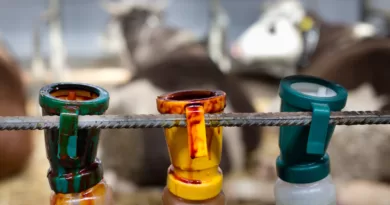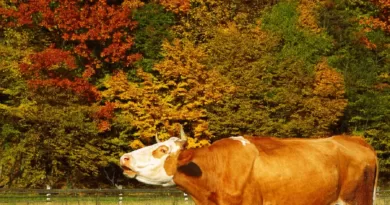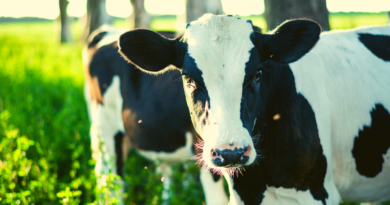Ovulation in Cattle. 100 Points Clear
What is Ovulation in Cattle?
Ovulation occurred within the first day after the end of estrus, the average time from the end of estrus to ovulation for 53 ovulations being 13.57 ± 0.68 hours. Sixty-seven per cent of the ovulations occurred between 8 and 16 hours after the end of estrus.
Ovulation in cattle is the process by which eggs are released from a cow’s ovary into her uterus. It’s one of the most important stages in reproduction as it’s key for fertilization and reproduction to occur. The average ovulatory cycle lasts around 21 days. The beginning with follicular development in the first few days and ending around when an egg is available for fertilization.
At the start of an ovulatory cycle, hormones such as estrogen prompt follicles (fluid-filled sacs) to develop within the cow’s ovary. After a few days these follicles will contain an egg, or oocyte, that can be released during ovulation somewhere between day 12 and day 16. Sometimes even later depending on environmental cues like temperature or daylight exposure.
During this time period cows may also display signs of estrus or “heat” where they become more active and respond positively to male attention. Although not all cows will display these behaviours some degree of heat can be expected. During this time frame before full-on mating behaviour presents itself on Day 18-22.
Once released, sperm have only a short window wherein they need to meet up with the oocyte so that fertilisation can occur. If no sperm meets up with the egg. Then it will simply dissolve away harmlessly until another oocyte develops over approximately 3 weeks later ready for release again at which point this whole process begins anew.
Fertility management forms extend far beyond just knowing when each individual cow’s next cycle could begin; through careful husbandry animal health professionals are able to foster reproductive success through monitoring hormone levels, nutrition + body condition scores – making sure your cattle are properly cared for is essential in increasing overall fertility rates & ensuring herd growth.
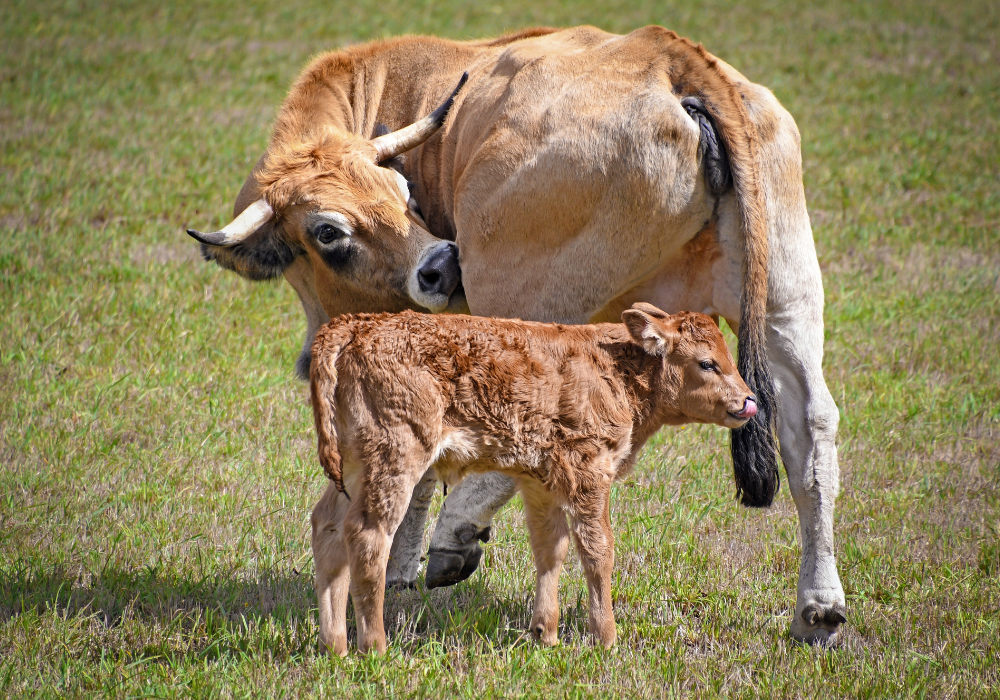
Endocrinology of the Estrous Cycle
The estrous cycle is an important part of the endocrinology of female mammals. It involves a complex and intricately timed sequence of hormones and physical changes that occur in reproductive organs, allowing for ovulation to take place. In cattle in particular, understanding the details of this process can be essential to their successful management.
First off, it’s important to know that the average duration of the estrous cycle in cattle is 21 days – although some individual cows have been observed with cycles lasting anywhere from 17-25 days. This means that ovulation typically occurs on day 8-10 after onset of heat (proestrus).
The cyclical ovarian activity begins when progesterone levels decline and estrogen production increases in what’s known as proestrus. As estrogen levels rise further, luteinizing hormone (LH) rises rapidly along with follicular growth –with follicles reaching over 30 mm by day 4/5 after proestrus. At this point, LH reaches its peak at around 12 hours before ovulation takes place. Thus playing a key role in stimulating follicle maturation and subsequent ovulation.
Once fully mature – which usually occurs 6-7 days after proestrus. The dominant follicle ruptures and releases an egg into the infundibulum portion of the oviduct where fertilization often occurs within a few minutes or hours post release if mating has taken place prior to this event.
Subsequently then, once released from its follicle corpus luteum begins forming from remains. The resulting in increased progesterone secretion while also creating other local environmental signals necessary for pregnancy initiation. Such as inhibiting further ovarian activity or inducing uterine secretory changes needed for establishment/maintenance until delivery date arrives months later.
In conclusion then we can see how precisely timed hormonal events coincide perfectly with physical structures like dominance hierarchies amongst ovarian follicles. So that now nearly every cow produces offspring each year without fail due largely due our modern understanding. All aspects involved with endocrinology behind estrous cycle they themselves.
Physiology of the Estrous Cycle in Cattle
The estrous cycle of cattle is a complex and fascinating biological process. It involves the repeated cycling of hormones, ovulation, and other physiological events that allow cows to become reproductive and conceive offspring.
When it comes to ovulation in cattle, it occurs around day 10 or 11 after the start of estrus—which is when sexual receptivity increases. When this happens, an egg will be released from one of the cow’s two ovaries. This egg then moves down the oviduct where sperm previously deposited by a bull during mating can fertilize it along its path. If no such encounter occurred, then the egg just passes through without being fertilized.
After ovulation, there’s a period known as luteal phase that lasts for approximately 14 days until progesterone levels drop low enough for estrus to begin again. During this time if fertilization did take place, then all sorts of interesting processes occur that make up pregnancy in cows (or any vertebrate mammal). On the other hand if no fertilization took place then everything simply reloads itself for another go at reproduction during what’s called metestrus: i.e., immediately before or simultaneous with estrus reoccurring around 18-24 days later than when it began last time round.
All told as amazing bits of biology we can only marvel at how intricate and perfectly coordinated these processes are so that reproductive individuals are able to create new life by bringing together genetic material from multiple individuals over periods lasting anywhere between 20-22 months.
Follicular Deviation
Follicular deviation, also known as follicle cyst or luteal cyst of the cattle, is a reproductive disorder that disrupts the normal estrous cycle in female animals. It occurs when an ovarian follicle fails to release its egg and instead forms a complex fluid-filled structure called a cyst that persists through multiple estrous cycles. Follicular deviation can be caused by nutritional deficiencies, hormonal imbalances, and environmental stress, which disturb the balance between follicular development and ovulation stages.
In cows and other domestic species with regular estrous cycles, normal reproductive behavior involves the growth of multiple follicles on the surface of each ovary at any given time during their 21-day cycle (in beef cows). These follicles develop over several days from small to large sizes (with a diameter range of 2mm – 12mm).
They secrete increasing levels of steroid hormones such as estrogen, which induce behavioral heat signs such as bellowing and restlessness when preparing for mating season. During this phase, one dominant follicle grows larger than others. Before releasing its mature egg into the Fallopian tube during the ovulation stage. Where it can be fertilized by sperm if present in the uterus for eventual fertilization or implantation within the uterus wall seven to nine days later, depending on the species gestation period.
However, while this process functions normally for the majority of the cow population. Sometimes, due to unknown causes, one or few large sizes growing ovarian cells become underdeveloped without reaching full maturity or failing to discharge their eggs. Due to persistent increases in estrogen levels of causing secondary effects disrupting estrus cycle patterned behavior leading formation “follicular deviation” syndrome. Among affected cows until the problem is resolved to allow them to return normal function. Soon after that with supportive care from veterinarian experts.
Normal Estrous Cycle in Cattle
The normal estrous cycle in cattle typically lasts 21 days and is divided into stages: proestrus, estrus, diestrus, and anestrus. Proestrus is the first stage that lasts 3-5 days and is characterized by increased progesterone levels. This is followed by a period of heat known as estrus, which occurs on day 5 or 6 of the cycle and can last anywhere from 8-24 hours. During this time, cows are most receptive to breeding and willingly accept a bull or artificial insemination (AI).
Following this heat period comes diestrus, which usually lasts 14 days for heifers (first-time calvers) or up to 18 days for older cows. Progesterone levels are elevated during distro while estrogen production declines, resulting in decreased receptivity towards breeding bulls/AI. Anestirus follows the distro and marks the end of one estrous cycle, lasting approximately 60-100 days before the start of another protestor phase begins the next cycle.
It’s important to know cattle’s normal estrous cycles so ranchers can maximize their chances of successful pregnancies when conducting AI programs using synchronized protocols such as Ovsynch or CIDRs for synchronizing follicular development so timed AI can be conducted at optimal intervals throughout the cyclic program (at day seven post synchronization) with maximal results achieved if done correctly.

Endocrine Effects on Multiple Ovulations in Cattle
The endocrine effects on multiple ovulations in cattle are an interesting and important topic to explore. Multiple ovulation is a process by which more than one ovum (a mature female egg) from the same estrous cycle becomes fertilized and develops into an embryo, resulting in multiple offspring from a single conception event.
There have been numerous studies conducted to investigate how hormones affect this process in cattle, with some fascinating results. In general, it seems that hormones play a large role in stimulating multiple ovulations. For instance, follicle-stimulating hormone (FSH), luteinizing hormone (LH), and progesterone are all known to be involved in the stimulation of multiple follicles during an estrous cycle. Many research teams have also found that FSH levels increase prior to the onset of ovulation when multiple ova are present during a given cycle.
In addition, there is evidence suggesting that different breeds of cattle may be more prone to higher rates of multi-ovulation due genetic factors related to their endocrine systems. Studies have shown differences between cows of various breeds regarding their estrogen receptor expression levels and other hormones associated with reproductive biology; certain breeds appear more predisposed towards responding differently when exposed to hormonal signals like FSH or LH, leading them sometimes produce increased numbers or larger sizes of eggs per estrous cycle compared others ones across different breed groups studied thus far as well as underlining important intra-species variations at the genetic level related with these physiological processes .
It’s clear from these studies that understanding the way hormonal influences shape each individual cow’s reproductive system could lead us closer towards better management strategies for optimizing breeding outcomes – making sure we can maximize fertility while improving quality assurance standards along side ethical concerns simultaneously within global livestock production systems today.
Estrous Control and Synchrony in Cattle
Regarding Estrous Control and Synchrony in Cattle, the timing and synchronization of a cow’s estrus cycle can be crucial for many reasons related to herd productivity. A well-timed estrus improves reproductive efficiency by allowing the cows to come into heat simultaneously, increasing the chances of getting pregnant when bred. Estrous control also helps keep calves born closer together, making them easier to manage and reducing labor costs associated with calving season.
Several techniques are used for controlling estrus in cattle, including hormonal medications, photoperiod manipulation (change in the amount of light each day), and nutrition management. Hormonal medication is effective for regulating cycling frequency and synchronizing cows coming into heat under given protocols on a farm or ranch setting.
An injection of synthetic progesterone known as melengestrol acetate is typically given twice, 45 days apart, on Days 0 and 45, which creates a synchronized wave within 18 days with peak activity on Days 12-15 post-first administration1. This allows producers/veterinarians to coordinate optimal breeding time intervals throughout their operation. While minimizing labor costs associated with monitoring signs of heat before treatment or during breeding groups for natural service.
The use of environmental manipulation such as photoperiod has actually been widely adopted due to its low-cost approach. Yet, the success rate may vary depending on how extreme (long vs. short) the photoperiod length is manipulated2. Typically shorter periods (14 hours daily dark period) result in asynchronous responses due to longer duration between heats cycles 3. Nutrition appears to have some role, but further research needs insight into specific metabolism pathways involved4. However, results from early studies suggest that synchronizing estrous tends to occur most effectively when energy balance is adequate5.
In summary, there are multiple ways available today that producers/veterinarians can explore when it comes to Estrous Control And Synchrony In Cattle so every operation can find what works best depending upon the specific type they are raising, individual goals they would like to achieve along with economic considerations present by their budgeting constraints 1-5.
Consequences of Multiple Ovulations and Twin Pregnancies in Cattle
When it comes to cattle, multiple ovulations, and twin pregnancies have serious consequences that can greatly impact the overall health of your herd. Multiple ovulations occur when more than one egg is released from the same cow during a single estrus cycle. Two or more embryos may be created within the cow’s uterus, leading to a double-gestation period. At the same time, this may not seem like such a problem at first glance. There are several issues associated with multiple ovulations and twin pregnancies in cattle.
First of all, having two embryos in the uterus can cause intense competition for nutrition from the mother’s body as both fetuses try to access resources needed for proper growth and development. This competition can often lead to one or both twins being undersized at birth. Inadequate nutrient intake throughout gestation periods can leave them weak and stunted compared with their singleton counterparts.
There is also an increased risk for miscarriage or stillbirths as multiple babies require additional strain put on their mother’s body during labour. Cows carrying twins usually cannot provide sufficient milk needed for proper nourishment. Post-partum results in increased odds of calf death shortly after birth, regardless of whether they reach full term.
In addition, cows carrying twins typically experience increased fat reserves around their flank area. Due to excess levels of progesterone hormone produced by the fetuses while attempting to keep them both viable during gestation periods. This leads to much fewer nutrients available for tissue production.
Later, this produces poorer quality beef, making these animals less valuable. Compared to those who carry only singletons per pregnancy, producers take hefty financial hits. Buying these animals’ livestock feedlots ultimately affects the industry’s bottom-line profits.
Finally, many veterinarians highly advise against artificial breeding. Any animal carrying twins as high risks involved often outweigh the potential benefits obtained via successful pregnancy. All–in–all, having multiple ovulations and twin pregnancies come with a ton of complexity. Producers must take extra precautionary steps to ensure each animal is healthy and safe. Before taking such risks, thus minimizing losses sustained through the process.
When does Ovulation happen in Cattle?
Ovulation in cattle typically occurs between the 12th and 16th days of their estrous cycle. During this period, the ovaries will release a single mature ovum (egg) into the fallopian tube, which is then ready for fertilization if it meets with sperm. The beginning of the estrous cycle starts when a cow nears sexual maturity. After being sexually active for several cycles, cows typically have regular cycles ranging from 18-24 days in length.
Typical signs of ovulation in cattle include increased mucus production around the vagina and behavioral changes such as mounting other cows or becoming very playful and active. Furthermore, during this time, body temperature will increase due to elevated progesterone levels associated with ovulation, and these temperatures can be monitored manually or via electronic means to detect early when ovulation is happening or may be about to occur soon.
In addition to detecting exactly when ovulation occurs within a cow’s estrous cycle, producers can gain many other benefits by monitoring their herd’s fertility status. These include ensuring successful conception rates through timing AI correctly, identifying animals that may not have some reproductive issues earlier on so they can receive treatment sooner rather than later, leading to better overall herd health and performance, as well as tracking calving/birth intervals more accurately amongst individual cows which allows for more efficient planning for instances like housing/accommodations during the birth season, etc. Therefore, it is beneficial for livestock owners to actively monitor their herd’s fertility status manually or electronically before and after the breeding season begins.
Delayed Ovulation in Cattle
Delayed ovulation is a condition in cattle where the female’s reproductive cycle is interrupted or disrupted due to environmental, nutritional, physiological, or other means. This can result in decreased fertility and delayed calving.
Environmental factors like temperature extremes and photoperiod (length of day) changes can affect the timing of ovulation. Nutrient deficiencies such as zinc deficiency from poor diets can also delay ovulation. Additionally, stress caused by excessive handling or overcrowding can lead to delayed ovulation in cows.
Hormonal imbalances and endocrine disorders may also cause problems with the cow’s estrous cycles that involve delays in post-partum ovarian activity and subsequent recoveries from those activities as well as altered follicular dynamics leading to an abnormal preovulatory LH surge pattern that triggers premature luteolysis of corpus luteum which then delays ovulation even more than normal post-partum patterns are expected to do.
To prevent this condition, farmers need to ensure optimal nutrition with enough vitamins and minerals. For their cows along with providing a stress-free environment by providing appropriate enclosure space necessary for socialization among the herd animals. Along with good hygiene practices while handling them during dips baths, etc.,
It help prevent infection-related hormonal disturbances leading toward delaying ovulation. Like this causing infertility issues later on down the road if not addressed early mutually between farmer veterinarians together. Collectively soon after being observed at the first instance itself. Such that early corrective measures could be taken long before a significant problem occurs down the line causing irreversible damages later on.
How Can we Manage Ovulation in cattle?
Managing ovulation in cows can be tricky, but it is possible with proper management. The key to successful ov.ulation management in cows is early detection and effective reproductive technology such as artificial insemination (AI), embryo transfer, and synchronization programs.
Early Detection
Early detection of estrus or heat cycles will help farmers better plan for more successful breeding outcomes. Cows can show signs of estrus when they are ready to be bred.
These signs may include increased activity,
- Restlessness
- Raised tail head position
- Mucous discharge from the vulva
- Lack of interest in feed and water consumption
- Mounting other cows or humans, and being more vocal than usual.
Proper observation will help farmers detect these changes earlier to prepare for AI accordingly. Additionally, using a cow-side pregnancy test (Ultrasound/Rectal palpation) will also provide additional information. About the cow’s reproductive cycle needed to better manage her ovarian status without having to bring her into an AI facility. This should improve fertility rates as well as ease up logistical challenges associated with bringing cows into AI facilities multiple times. To detect estrus cycles due to transport by reducing stress on already stressed animals during the breeding season.
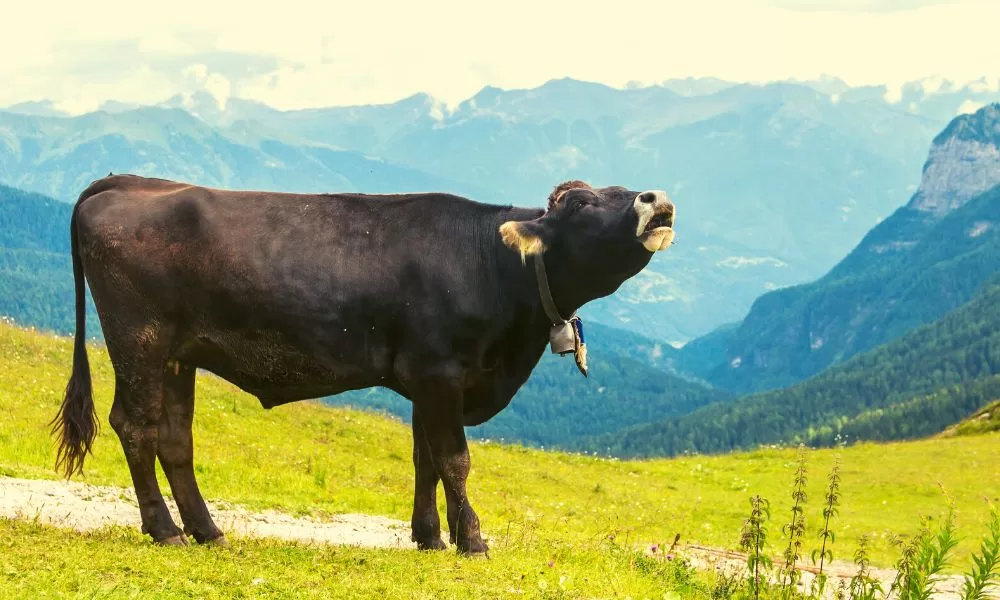
Reproductive Technology:
Artificial Insemination (AI) has been used successfully for many years by dairy producers worldwide. This offers several advantages over standard natural service, including the lower cost involved. When compared with purchasing bulls (when considering larger herds). Furthermore, having one sperm source allows producers greater control over genetic quality within their herd. It would allow for better selection when it comes to sire choice based on desired traits. These are important within certain breeds – critically. This is especially true if there’s only access to limited numbers of bulls available locally or nationally throughout the year.
Thus making sure valuable genetics aren’t lost. Due to fertilization failure caused by poor timing. When relying solely upon natural service methods. Alone for those willing & able to source semen online from major frozen semen bankers. Across the globe with stallion lists numbering well over hundreds of not thousands combined – proven lactation performance data. Likewise provided per each sire available under each respective library. Alongside its accompanying pedigree info too now becoming commonplace today among them all too.
What Happens if Ovulation Fails in Cattle?
If ovulation fails in cattle, the oocyte (immature egg) will not be released from the ovarian follicle. This can occur for various reasons, including nutrient deficiencies or other health problems with the cow. The result is an inability to reproduce, which could have serious implications for a dairy farmer’s long-term success.
Ovarian follicles are produced by hormones released from the pituitary and hypothalamus glands located in the brain. Ovulation occurs when two hormones, LH and FSH, are released within 24 hours. Suppose ovulation fails due to low hormone production levels or a lack of response to these hormones. In that case, oocytes will not be as readily available for fertilization, and pregnancy attempts may fail more often than usual.
To prevent ovulatory failure in cattle. Cows must receive proper nutrition through their diet and access to plenty of fresh water and minerals. Such as sodium chloride, calcium carbonate, potassium chloride, zinc sulfate, and magnesium oxide. Other factors, such as stress, should also be minimized.
So that there is no additional interference with reproductive cycles. Last but most importantly, regular vet checkups should be conducted on all animals throughout their life cycle to identify any potential issues. Before them having a major impact on fertility or productivity levels.
Additional Risk Factors for Multiple Ovulations.
Multiple ovulations occur when a female animal produces more than one ova (eggs) during a single breeding cycle. This phenomenon is observed in many species, including cattle. While some cases of multiple ovulation are natural eventsa. Certain risk factors can cause the occurrence of multiple ovulations to increase significantly.
Nutrition is one of the main risk factors for increased multiple ovulation in cattle. Suppose a cow does not receive enough nutrients for adequate growth and development. In that case, her body will be unable to sustain an appropriate level of reproductive health. It leading to increased irregular egg production or multiple ovulations. Additionally, cows kept in poor conditions often face higher risks from disease and environmental stress. It can lead to multiple-ovular responses as the animal’s body attempts to cope with the unfavorable environment it finds itself in.
The genetic composition is another potential risk factor for increased rates of multiple ovulations among cattle. Studies have demonstrated that some breeds appear predisposed towards hyperextended follicular development or excessive “splitting,”. The resulting in up to 16 offspring from a single mating event. Due to high rates of twinning or tripletting associated with certain genotypes (e.g., Charolais).
More recently identified genetic variants linked specifically to important traits like milk yield. It may also confer an increased likelihood of double or triple mate conception amongst individuals carrying. Such alleles as well as predict pregnancy outcomes from advanced embryo transfer procedures involving pluriparous organisms. Containing complex arrays of fetal material obtained prenatally through multi-oocyte collections protocols per Gjedrem et al.
Finally, artificial stimulus induced by reproductive manipulation techniques employed by livestock producers presents another potential source causing elevated instances. Where animals exhibit frequent poly ovular outcomes depending on how strategically these methods are managed over time. Whether done routinely or just occasionally during times needed. Most economically sufficient for operations viability greater ensuring uniformity within calves. Both date-wise & size-wise prior sale arrivals, etc.
Examples here would include approaches like,
- Progesterone treatments designed artificially induce new luteal phases.
- Once previous ones have exhausted their hormonal resource pooling capabilities optimally leveraging cost-effective production parameters. While at the same time increasing input outputs/conception marking success rate.
- Overly making use of hormone injections given available evidence-based literature facts currently supporting their practical application far much more.


